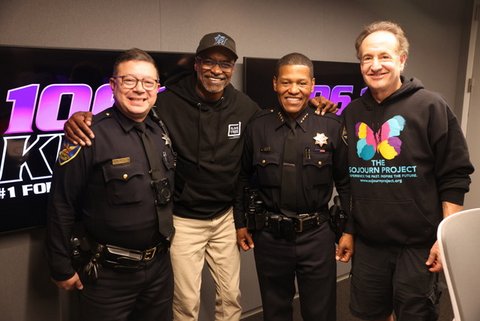
05 Mar Learning from the Past: SFPD Officers Gain New Perspectives on Race and Policing

Dr. Joseph Marshall, second from left, hosted San Francisco Police Officer Al Duarte, from left, SFPD Chief Bill Scott and Jeff Steinberg of the Sojourn Project on “Street Soldiers Radio” about a trip to teach officers about civil rights history.
Interview by Dr. Joseph Marshall Jr., “Street Soldiers Radio”
Editor’s Note: The following conversation took place Feb. 23 on the long-running community radio program Street Soldiers. Show host Dr. Joseph Marshall Jr. welcomed San Francisco Police Chief Bill Scott; Jeff Steinberg, the executive director of the Sojourn Project; and San Francisco Police Department members to discuss an initiative to take officers on an immersive journey through civil rights history. The civil rights sojourn is aimed at fostering greater empathy, understanding and cultural awareness among law enforcement officers by exposing them to the lived experiences of the African American community during the Civil Rights Movement.
Below is a transcribed portion of that radio program, which has been edited for clarity.
Dr. Joseph Marshall: The San Francisco Police Department is here to talk about something that they have been doing for a while, about which I just found out. They have been taking their officers on a sojourn, a civil rights Black history tour. This fits with our last show on Black History Month. When I found out, I got the chief on the phone and said, “Chief, you got to come on Street Soldiers and tell the world about this.”
Chief William Scott is right here to my left. I want to say, from the citizens of San Francisco, thank you for the great job that you do. Thank you for the work that you’ve done. I know you’ve worked hard. You know, ups and downs, nothing harder than being a police chief. But you have done — as far as I’m concerned — a wonderful and admirable job. Let’s go straight to this thing. Where did you get the idea to take officers on a civil rights, Black history sojourn.
Chief Bill Scott: Well, actually, it was more of me finding out about the man sitting to my left, Jeff Steinberg, and the program that he had been doing for many, many years before we got involved. And it was in the aftermath of George Floyd when we really needed to do something to address all the issues that were happening. These issues have been happening for a very long time. But the death and murder of George Floyd, I think, brought it to a head in policing in America. So it’s really hard to even have a conversation about these issues when race is the thread that cuts in between many of the issues that we see in policing. And we were trying to figure out a way to do that.
>>From The Pulse Archives:
What’s Changed in Policing in a ‘Post-George Floyd’ America<<<
One of our members of our command staff had gone on this trip with Jeff when she was a teenager. It just so happened that my wife, her family [was connected to] Lisa McNair, who is the sister of one of the four little girls killed in the 16th Street Baptist Street Church.
So that year, we did a Black history message and video, and I talked about my memory and relationship through my wife, through Lisa’s family, and my father-in-law, who was a pallbearer for three of those four girls murdered in that bombing. That led to Lisa seeing the video. My wife sent it to her sister, and my sister-in-law sent it to Lisa, and that led to me having a conversation with Lisa, which led to her recommending that I talk to this man named Jeff Steinberg. And as they say, the rest is history.
I called Jeff, and we set up a couple of meetings through Dianna Aroche, who’s our staff member. Dianna set up the meeting, and Lisa, I guess, put in a good word, and Jeff was gracious enough to meet us. It just clicked from the first meeting, in my opinion, and we just knew we had something that we wanted to follow up on, something special. And that led to these trips, these journeys to take officers to the South… Alabama, Mississippi, Tennessee, to actually walk in the footsteps and talk to these civil rights icons who paved the way for us to do everything that we’re able to do today and learn that history that is not necessarily in the history books.
The other thing was to relate that back to our jobs. How does that impact what we do, even today? And officers. Do they have a good understanding of the history that many people bring with them when they interact with the police officer that really has nothing to do with the officer personally? A lot of times it’s the institution that has impacted them one way or another. So this trip serves the purpose of bringing that all together. And we partnered with Jeff and Sojourn, and we’ve taken, I think, seven journeys now, over the last two and a half years. It continues to get better. We have invited other police departments in the Bay Area, San Mateo PD, Alameda County Sheriff’s, San Francisco Sheriff’s. And it has really taken off so and been very rewarding.
Marshall: Police officers? Just to wrap your mind around the concept of police officers going on a Black history tour is unprecedented. It’s mind-boggling. And I’m sure all the listeners know the often-fraught state of relations between the police and particularly the Black community. And what I tell people all the time when we do these shows is that there are 18,000 I think, police, jurisdictions in the country, and there’s no central control. So each department has to do whatever reform and accountability individually. You, Bill Scott, for police in San Francisco, have done something that’s unprecedented.
I just want to say how remarkable to me this thing is.
Jeff, I’m going to pull you in now. You have been doing these tours for a while, so why don’t you talk about … when you first heard that the SFPD might be interested in this.
Jeff Steinberg: When I heard Chief Scott was from Birmingham, Alabama, and the police chief… instant connection. And how can one not be drawn when you meet Bill Scott? His generosity of spirit knows no bounds.
He has laid out such a beautiful vision for how people can have a transformative experience. And I put it in simple terms. Much of the violence done in the civil rights movement was done by law enforcement. So when we take law enforcement people into the Deep South, and they see what happened, to meet the real people who experienced it, the hope is they will come back with more compassion and empathy when they’re on the streets. They’ve seen firsthand what violence and racism can do.
Marshall: We are showing the “Freedom Riders” [documentary] right now to the kids, and when those young people see these Freedom Riders getting off the bus and the co-conspirators in the attacks on them, be the police officers. You are absolutely right when you say that, absolutely.
Steinberg: Oh, it was totally conspiratorial. With governors involved, with the white business community, and with the complicity of officers, including the federal government and the FBI.
Marshall: Let’s go back to when you started. Let’s get the history of you and the tour itself.
Steinberg: I was a history teacher at a high school in San Bruno called Capuchino High School. I taught U.S history. I was a department chair and taught AP and other levels. My last year, I just wanted to take 30 kids from my own class into the South. We took 100 the first year, and I realized really quickly, this wasn’t just for me or my students, so I took a leave of absence from the district. I taught in the San Mateo Union High School District. District’s never given a teacher more than a two-year leave. They gave me seven years in a row, and then they said, please resign. So I formed the nonprofit organization called Sojourn, and we are in our 25th year. For the first 21 years, we had taken high schools and colleges and middle schools. And then I got blessed with Bill Scott coming into my life, and the SFPD, and my dear friend [Officer] Al Duarte.
Going in and meeting officers who I had preconceived notions about. Chief Scott has set the tone — this is an academic learning experience; we want you to bring the lessons you learned back into the job. As opposed to just a civil rights journey, we do the historical stuff that I help lead in the morning and afternoon sessions, meeting people, going places, museums, being in people’s homes, sites where stuff happened. And then, Chief Scott leads a discussion each night about how what you learned ties into policing today. With community members and with officers, and we have district attorneys who’ve come as well. Our DA in San Francisco, Brooke Jenkins, has come on this with many DAs. But watching Chief Scott lead the discussions is putting the puzzle together. How are they going to approach it at home? So the nighttime is dedicated to Chief Scott’s vision of what he wants them to take home with them.
Marshall: Give me the itinerary. Where do you go?
Steinberg: We fly into Montgomery, Alabama, and on day one is dinner, get to know each other. Day two, we go to the Legacy Museum led by Bryan Stevenson, arguably the best museum I’ve ever been in.
Earlier that day, before we go to Legacy, we’ve met one of the Little Rock Nine. Her name is Minnijean Brown-Trickey. Minnijean was the only one that I know that was expelled at age 16. And it wasn’t done by happenstance. It was institutionalized; they wanted to get her out. Minnijean comes on the whole trip for the full six days. She’s 83 years old. She comes on the trip to hang out with the officers. I’ve done 120 trips, and Minnijean has been on 115 of them. She is so knowledgeable and imparts what she knows the whole way through the trip.
Day three, we go to Birmingham and we meet a woman named Gwen Webb who was involved in the Children’s March, which led to the desegregation of Birmingham, led by the Rev. Fred Shuttlesworth. He’s one of the big three of the civil rights movement. His following was kids, and they literally filled up the jails, arrested by law enforcement in brutal fashion: with dogs and fire hoses. We’ve seen the footage. Gwen Webb was there, arrested at 15. She meets us and shares her incredible story.
Then, we go to the 16th Street Baptist Church. It becomes our classroom, and we do music, readings, film — inside the church where these four little girls were killed. And then, Lisa McNair meets us. Lisa’s sister Denise was killed in the church bombing. Lisa was born a year and four days after her sister was murdered.
Then, we meet Sarah Collins. Sarah was blinded at 12 in the church bombing. Her sister Addie Mae was murdered. Sarah shares how she wanted to die and how she found hope. She shares that path in the church where this happened. Then, we have dinner made by Lisa’s sister, Kim McNair, an incredible chef.
From there, we go on to Hattiesburg, Mississippi. Hattiesburg is the home of an incredible family called the Dahmers. Vernon Dahmer was an African American man who had a grocery store, and he was helping people pay the poll tax in 1966 to help them register to vote. The Voting Rights Act was passed in 1965; people are still paying the poll tax in 1966. He said, if you can’t afford to pay your poll tax, I will help you pay it. He had money.
>>>From The Pulse Archives:
Attacks on Voting Rights Evoke Jim Crow Era<<<
Well, he’s in bed on Jan. 9, 1966. His wife and him had slept in shifts for years because they had so many threats on their lives. They would not sleep together in the same bed. Two in the morning, Jan. 10, seven Klan members drive by their house. They have firebombs, Molotov cocktails. They throw them in the house. House lights up on fire. Vernon gets his wife, Ellie, outside. He gets his three kids, Dennis, Betty and Harold, out their windows. Vernon has guns to scare the Klan and fires back. He breathed in too much smoke, searing his lungs. He dies the next day. On his deathbed, they allow a reporter to come in, and some of the last words Vernon said before he died were, “If you don’t vote, you don’t count.” That’s written on his tombstone. So who meets us in Hattiesburg, Mississippi at their house? We meet his wife, Ellie Dahmer, who’s now 99 years old.
We also meet Dennis Dahmer, who was 12 years old in the house that night, and his sister Betty, who was terribly burned in the fire. They share their father’s legacy. Because the story of Vernon Dahmer is not how he died; the story of Vernon Dahmer is how we live.
The people we meet on this trip — this line gets me in trouble, but I don’t mind — they are, in my opinion, the real founding fathers and mothers of this country. They believed in real freedom, unlike Washington and Jefferson, those two being slave owners. They may have done great things for this country, but we must remember, if you’re a slave owner, that means, by definition, you’re a racist. These people lived in real freedom, and they’re not in our history books, so we’ve been ripped off, [not] knowing their stories. That’s why we like to bring the Dahmers to life.
When we leave Birmingham, we go to Memphis, and we go to the Lorraine Motel where Dr. King was assassinated. We play his mountaintop speech. And the lesson really is, it’s not what’ll happen to me if I help out my fellow Americans — what’ll happen to them if I don’t?
And that’s what the police do. And this is all tied into the principles of nonviolence, which Minnijean is a firm believer in, because the first principle of nonviolence says nonviolence is way of life for courageous people. Who’s more courageous than our officers on the streets? Principle No. 2 says nonviolence believes in friendship and understanding. What are officers doing on the streets? Friendship and understanding. So the principles of nonviolence directly correlate to policing.
Elizabeth Eckford also meets us. Elizabeth is one of Little Rock Nine. You’ve all seen the famous photo of the young, 15-year-old being screamed at by the white mob who wanted to lynch her on that first day. Elizabeth has come on the police trips, and she says it’s some of the best work she’s ever seen law enforcement do. She has become friends with Chief Scott as has Minnijean, and they are so proud of the work Chief Scott is doing.
We take community members, so you’re all invited, but I think it needs to be said, it doesn’t happen without leadership. And the leadership of Bill Scott cannot ever be discounted or dismissed because he leads by example
Marshall: Chief Scott, was there any pushback when you brought this idea?
Scott: Not everybody bought into it. Nobody was made to go, at least from our department. That’s where Officer Duarte and Lt. Lee and some other folks helped us get this off the ground. They got people who were interested in going, were interested in learning, interested in whatever the training was going to do to make us better at what we do — and better people. Not just better police officers, but better people. But as we started to go along, more and more people started to want to come. Now, we got more people who want to come than we can take.
There’s a bonding experience that happens on these trips where we actually get to spend time with each other away from the regular routine of the office or the police station. It serves the purpose to kind of break down the barriers.
Steinberg: Chief Scott has an incredible team that implements his vision, because it has to be organized. Officer Duarte is an incredible organizer to make this vision happen as is Diana Aroche and Lt. Kinley, who have made the chief’s vision happen.
Marshall: Officer Duarte, talk about your involvement with the tour. And if you’ve gone, what have you seen?
Officer Al Duarte: We’ve done seven. The first one I did not attend. I have attended six out of the seven. I helped coordinate and just make sure that the chief gets his rest.
I’m a supporter of anything Bill Scott talks about not only because you’ve praised him as a humanitarian, and is he is that. But he’s a diplomat. I think every chief tries to get to know his officers, and that’s important. But he actually does spend the time. During these trips, you get to know every single one that comes. So I was a supporter from the moment I heard about it, and I was a supporter from the minute I got off the plane and met Jeff. And, by the way, class started the minute we got off the plane.
Scott: For some people, there’s a thing about, hey, it’s not me — what happened 40 years ago, 60 years ago, 100 years ago, it’s not me, which is true. But it doesn’t negate the fact that we need to acknowledge this history. We need to learn from it, so we don’t step into it again and do the same thing. In policing, I think that’s critically important. We understand the impacts that this profession has on people’s lives, and we have to take that history to make us better.
Steinberg: The goal is that white people don’t feel guilty and that people of color don’t shut down, because we need the dialogue together. My example that I give young kids is, as a Jewish person, a 17-year-old German kid is not responsible for the Holocaust.
>>>Read: Holocaust Survivor’s Life Is an Open Book Come Alive<<<
They did not do it, but they certainly need to know about it, and they certainly need to make sure it never happens again and know those lessons. Because we want to exonerate the guilt, because it’s not about people feeling guilty where they won’t participate in the process.
Marshall: So Commander Derrick Jackson, talk about when you first heard about this sojourn into the past tour. What were your thoughts? What made you decide to go?
Commander Derrick Jackson: When I initially heard about sojourn, I declined to go. I was a new captain at a district station, and I was heavily involved in my work, and I figured I knew enough about the civil rights, and why would I do this? But to Chief Scott’s credit, he approached me again, and he encouraged me to not only grow professionally but to grow personally and understand culturally how the perceptions of police impact our relationships with the communities we serve. So I did go when I was approached the second time.
I thought that what I had learned in school, from grade school, high school, right up into college, was accurate and sufficient when it came to civil rights. But I was very naive and completely mistaken. I’ve been around the city a long time and never really experienced the violence and the hatred that our forefathers and civil rights movement went through. My parents are from Louisiana, grandparents from Louisiana, and growing up, you’d heard about the stories of segregation and racism, but I don’t think I really clearly understood the impact it had on members of my family.
Just looking at the 400 years of American history, from enslavement, racial terrorism, segregation to mass incarceration, it really changed the way I look at how we deal with our communities. If we look at how the police and the military were used to perpetuate segregation, it’s understandable how our community perceives us as police today. So returning from this trip, I returned with a better understanding of how to approach my community, especially in the areas that I worked, the Western Addition, the Bayview, Hunters Point, and to help understand the community’s perception of policing and to help overcome some of the obstacles that we were facing. So it was a completely impactful trip to me.
I served as an adjutant to Chief Scott, and my role on this second trip was to encourage my peers and co-workers to join and experience the journey. As Chief Scott said, we opened this trip up to our partnering agencies, and to see how they experienced it for the first time, and what they took away from it, is memorable.
Marshall: Sgt. Pete Richardson, what was your experience on the trip?
Sgt. Pete Richardson: It was a powerful trip. It’s a journey. It’s an experience. I was lucky enough to get invited twice, and I jumped at the chance to go a second time. It’s a life-changing experience that the chief and Jeff gave me, and I’ll be forever grateful. One of the first places I went to was this lynching museum. You look at all the stories of folks that were lynched for reasons that are just ludicrous. The things that you learn on this trip … It just leaves you speechless.
And to meet these icons, these warriors that I call them, the Dahmer family really, really touched my heart. They take us to their home, and you get to see bullet holes in trucks and cars that are still on their property, [from] when the KKK attacked him. It’s really something. You get to hear Ellie, who’s in her 90s, tell the story, and it’s shocking. You listen to these people, and they invite you into their home, and they treat you with respect, and they talk to you, and they educate you. Plus, you look like the people that caused them so much pain years ago. It’s powerful man. It’s something else.
What did I learn from the trip? I came back and I realized that there was one theme that really stuck to my heart. We do have a tough job, and we come across people doing that job that are really in bad shape, in a bad place in life. As long as we can treat them with respect and dignity — and try not to take that away from them — I think that’s a little part of the chipping away that I can do.


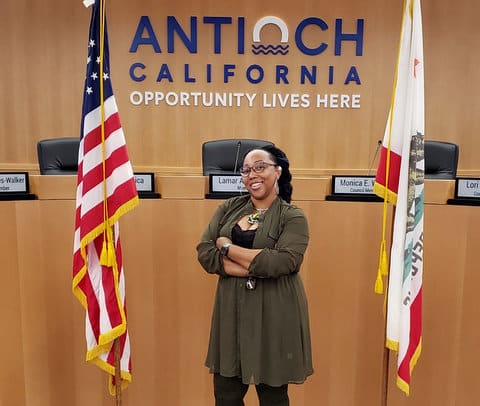
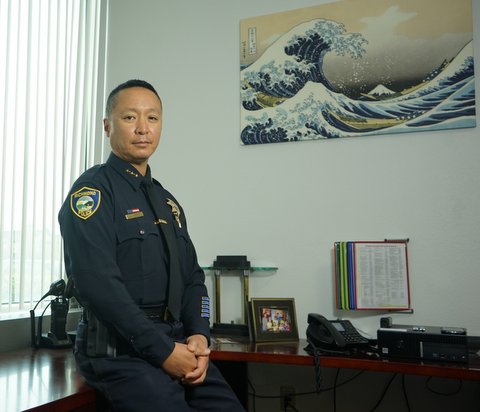
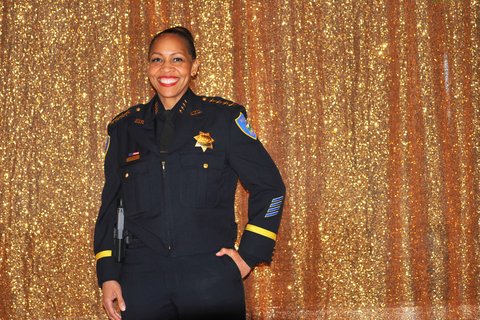
No Comments